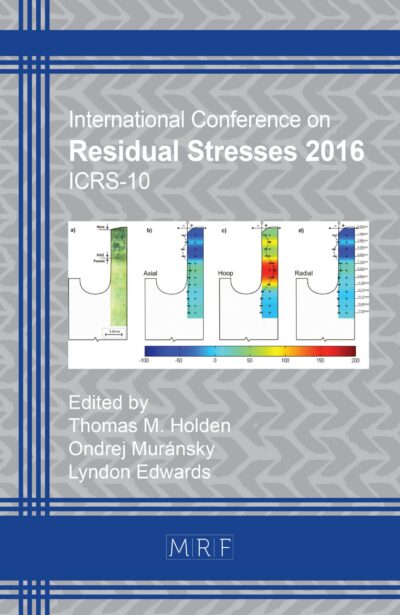–
Influences of die shape and calibration strokes on surface near residual stresses of rotary swaged steel tubes
LANGSTÄDTLER Lasse, CHARNI Dhia, SCHENCK Christian, EPP Jeremy, KUHFUSS Bernd
download PDFAbstract. Forming processes offer a great potential to make production more sustainable by including both the shaping of the geometry and the improvement of the material properties. Through a better understanding of the decisive influencing factors on the resulting material properties of the part, this potential can be particularly exploited and leads to the chance of shortening process chains by e.g. saving heat treatment steps. The part properties during rotary swaging can be improved by strain-induced residual stresses. Thereby, compressive residual stresses can increase the resistance to fatigue fracture, to crack propagation and to corrosion. However, rotary swaging of tubes can lead to undesirable residual tensile stresses at the surface with high fluctuations. Therefore, a better understanding of the rotary swaging process and the actual material flow is necessary. The aim is to realize compressive residual stresses with low fluctuations. Thereby, it is of interest to be able to set residual stresses independently of the desired workpiece geometry. In this paper, rotary swaging of E355 steel tubes (Ø20 mm x 3 mm) was carried out with two different process adaptions. These two adaptions are the number of calibration strokes and the die geometry. They show different influences on surface near residual stresses.
Keywords
Forming, Rotary Swaging, Residual Stresses, Steel Tubes
Published online 4/24/2024, 7 pages
Copyright © 2024 by the author(s)
Published under license by Materials Research Forum LLC., Millersville PA, USA
Citation: LANGSTÄDTLER Lasse, CHARNI Dhia, SCHENCK Christian, EPP Jeremy, KUHFUSS Bernd, Influences of die shape and calibration strokes on surface near residual stresses of rotary swaged steel tubes, Materials Research Proceedings, Vol. 41, pp 901-907, 2024
DOI: https://doi.org/10.21741/9781644903131-98
The article was published as article 98 of the book Material Forming
![]() Content from this work may be used under the terms of the Creative Commons Attribution 3.0 license. Any further distribution of this work must maintain attribution to the author(s) and the title of the work, journal citation and DOI.
Content from this work may be used under the terms of the Creative Commons Attribution 3.0 license. Any further distribution of this work must maintain attribution to the author(s) and the title of the work, journal citation and DOI.
References
[1] P. Grupp, C. Kienhöfer, Rotary Swaging Technology, Felss GmbH, Germany, (2003).
[2] S.-J. Lim, H.-J. Choi, C.-H. Lee, Forming characteristics of tubular product through the rotary swaging process. Journal of Materials Processing Technology 209 (1), (2009) 283-288. https://doi.org/10.1016/j.jmatprotec.2007.08.086
[3] A. Ameli, M.R. Movahhedy: A parametric study on residual stresses and forging load in cold radial forging process. Int. J. of Advanced Manufacturing Technology 33, (2007) 7-17. https://doi.org/10.1007/s00170-006-0453-2
[4] G. Singh, R. Raj , V. Narayanan K I, U.K. Arora , R. Jayaganthan, The effect of die design on residual stresses of Zr-4 alloy processed by swaging, Procedia Struc. Integrity 46, (2023) 149-154. https://doi.org/10.1016/j.prostr.2023.06.025
[5] ASM Committee on Rotary Swaging, Rotary Swaging of Bars and Tubes, in: Metals Handbook Vol. 14 Forming and Forging, 9th ed, Ohio, Am. Society for Metals, (1988) 268-309.
[6] D. Charni, S. Ishkina, J. Epp, M. Herrmann, C. Schenck, H.W. Zoch, B. Kuhfuss, Residual stress generation in rotary swaging, Proceedings of the 5th International Conference on New Forming Technology, Bremen, Germany, (2018). https://doi.org/10.1051/matecconf/201819004001
[7] S. Ortmann-Ishkina, D. Charni, M. Herrmann, Y. Liu, J. Epp, C. Schenck, B. Kuhfuss: Development of residual stresses by infeed rotary swaging of steel tubes, Archive of Applied Mechanics, (2021). https://doi.org/10.1007/s00419-021-01905-5
[8] L. Langstädtler, K. Moazzez, D. Charni, C. Schenck, J. Epp, B. Kuhfuss, Residual stresses generation in multi-stage rotary swaging of steel tubes, Lecture Notes in Mechanical Engineering, Springer, (2024).
[9] H. Hoche, F. Jaeger, A. Franceschi, M. Oechsner and P. Groche, Formation of Residual Stresses in Austenitic Stainless Steels by Infeed and Recess Rotary Swaging. in: Daehn, G. et al. (eds) Forming the Future, The Minerals, Metals & Materials Series, Springer (2021). https://doi.org/10.31224/osf.io/6uks7
[10] I.C. Noyan, J.B. Cohen, Residual Stress Measurements by Diffraction and Interpretation, Springer, New York, (1987). https://doi.org/10.1007/978-1-4613-9570-6
[11] L. Kunčická, A. Macháčková, N. P. Lavery, R. Kocich, J. C.T. Cullen, L. M. Hlaváč, Effect of thermomechanical processing via rotary swaging on properties and residual stress within tungsten heavy alloy, Int. J. of Refractory Metals & Hard Materials 87, (2020). https://doi.org/10.1016/j.ijrmhm.2019.105120
[12] Research report of the priority program SPP2013, Utz Verlag – in print, Germany, (2024).













